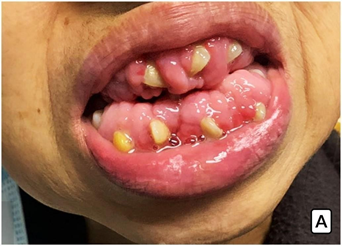MOJ
eISSN: 2379-6162


Case Report Volume 11 Issue 1
Faculty of Medical Sciences, Universidad de San Carlos de Guatemala, Guatemala
Correspondence: Dra. Ana Trabanino, Faculty of Medical Sciences, Universidad de San Carlos de Guatemala, Guatemala
Received: February 05, 2023 | Published: February 20, 2023
Citation: López-Monzón M, Vivar A, Ruano C, et al. Severe gingival hypertrophy associated with the use of phenytoin a case report. MOJ Surg. 2023;11(1):17. DOI: 10.15406/mojs.2023.11.00212
Drug associated gingival hypertrophy is an adverse effect of a large number of drugs (anticonvulsants, calcium channel blockers, immunosuppressants), which in addition to being used in daily medical practice, these drugs are for continuous use. We present the case of a 50-year-old female patient diagnosed with convulsive disorder with 42 years of use of phenytoin.
Keywords: gingival hypertrophy, phenytoin, adverse effect, anticonvulsants
Gingival hypertrophy (GH) was first described in 1939, since then the cases have increased.1 However, the prevalence of GH is variable, which makes it difficult to define. More than 20 associated drugs have been described as the cause of GH; classified in 3 groups: anticonvulsant, calcium channel blockers and immunosuppressants.1–3
These drugs have various mechanisms of action and effects on different systems, but a fibrogenic action and increased collagen production have been identified.2 Risk factors include a genetic component of susceptibility to these drugs, poor oral hygiene, bacterial plaque accumulation, dental and periodontal microtrauma.1
50 year-old female patient, who consulted for gingival enlargement, which started about 5 years ago. Patient with a history of convulsive disorder treated with phenytoin 300 mg per day for 42 years, with no other history of importance. On physical examination, the oral cavity showed incomplete dentition, tartar accumulation, bacterial plaque, gingival overgrowth partially hiding the dental crowns, shaped as globular masses, with preserved mucosal texture and firm consistency. Partially occluded oral cavity, with sialorrhea (Figure 1).

Figure 1 Gingival hypertrophy, globular shape, accumulation of tartar and bacterial plaque in dental pieces.
The patient was referred to the Maxillofacial Surgery department, where the treatment was divided into an educational plan, oral cleaning (cleaning, plaque control, tartrectomy and use of 0.2% chlorhexidine diacetate). The next part of the treatment was the planning of surgery with gingivectomy technique and antibiotic therapy.
Up to 50% of the patients treated with phenytoin may suffer from gingival hypertrophy, although the main etiology has not been described, it is known to be multifactorial. Authors have associated gingival enlargement with an inflammatory component in the gums, which explains poor hygiene and the presence of bacterial plaque as a risk factor.2 There are hypotheses of the proinflammatory role of interleukins, platelet-derived polypeptides, local inflammatory factor of fulfilled glycosaminoglycans, immunoglobulins and activation of epithelial growth factors and fibroblasts.
The fundamental role of extracellular matrix-derived metalloproteins that interfere with proper collagen synthesis and function of collagenases and proteases has been demonstrated.2,3 As a result of phenytoin abuse in medical practice and lack of adequate epidemiological description in the literature, the authors emphasize the extension of the educational plan from the beginning of treatment with the drugs described.
None.
The authors declare no conflicts of interest.
None.

©2023 López-Monzón, et al. This is an open access article distributed under the terms of the, which permits unrestricted use, distribution, and build upon your work non-commercially.